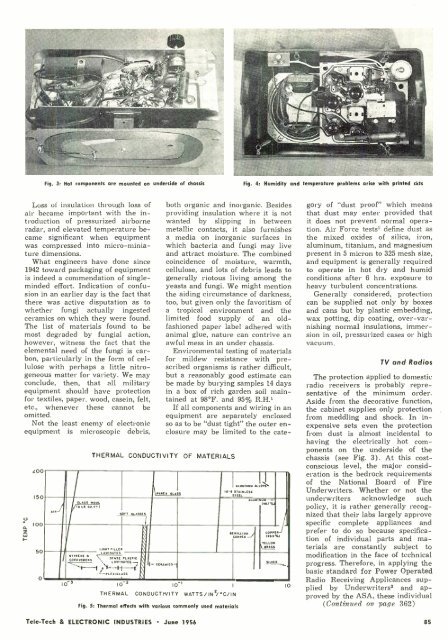TELE-TECH & - AmericanRadioHistory.Com
TELE-TECH & - AmericanRadioHistory.Com
TELE-TECH & - AmericanRadioHistory.Com
You also want an ePaper? Increase the reach of your titles
YUMPU automatically turns print PDFs into web optimized ePapers that Google loves.
Fig. 3: Hot components are mounted on underside of chassis<br />
Fig. 4:<br />
Humidity and temperature problems arise with printed ckts<br />
Loss of insulation through loss of<br />
air became important with the introduction<br />
of pressurized airborne<br />
radar, and elevated temperature became<br />
significant when equipment<br />
was compressed into micro- miniature<br />
dimensions.<br />
What engineers have done since<br />
1942 toward packaging of equipment<br />
is indeed a commendation of single -<br />
minded effort. Indication of confusion<br />
in an earlier day is the fact that<br />
there was active disputation as to<br />
whether fungi actually ingested<br />
ceramics on which they were found.<br />
The list of materials found to be<br />
most degraded by fungial action,<br />
however, witness the fact that the<br />
elemental need of the fungi is carbon,<br />
particularly in the form of cellulose<br />
with perhaps a little nitro -<br />
geneous matter for variety. We may<br />
conclude, then, that all military<br />
equipment should have protection<br />
for textiles, paper, wood, casein, felt,<br />
etc., whenever these cannot be<br />
omitted.<br />
Not the least enemy of electronic<br />
equipment is microscopic debris,<br />
U<br />
eo<br />
15<br />
I<br />
GLASS WOOL<br />
Is u. cu. FT.,<br />
both organic and inorganic. Besides<br />
providing insulation where it is not<br />
wanted by slipping in between<br />
metallic contacts, it also furnishes<br />
a media on inorganic surfaces in<br />
which bacteria and fungi may live<br />
and attract moisture. The combined<br />
coincidence of moisture, warmth,<br />
cellulose, and lots of debris leads to<br />
generally riotous living among the<br />
yeasts and fungi. We might mention<br />
the aiding circumstance of darkness,<br />
too, but given only the favoritism of<br />
a tropical environment and the<br />
limited food supply of an old -<br />
fashioned paper label adhered with<br />
animal glue, nature can contrive an<br />
awful mess in an under chassis.<br />
Environmental testing of materials<br />
for mildew resistance with prescribed<br />
organisms is rather difficult,<br />
but a reasonably good estimate can<br />
be made by burying samples 14 days<br />
in a box of rich garden soil maintained<br />
at 98 °F. and 95% R.H.1<br />
If all components and wiring in an<br />
equipment are separately enclosed<br />
so as to be "dust tight" the outer enclosure<br />
may be limited to the cate-<br />
THERMAL CONDUCTIVITY OF MATERIALS<br />
SOFT GLASSES<br />
100<br />
,II<br />
:o'...4:.11 issiXl<br />
,ELLOS<br />
LIGFT FILLS.<br />
50<br />
`<br />
WASS<br />
LAMINATES<br />
~<br />
STTWEFE<br />
PLASTIC `<br />
CC.GLESEFS<br />
\°:.f F[4<br />
, F-CG.SIGS--I<br />
SILVER<br />
LL y EEI6L.SS 1<br />
'<br />
o<br />
THERMAL<br />
u.<br />
s<br />
CONDUCTIVITY WATTS /IN2 /C /IN<br />
Fig. S: Thermal effects with various commonly used materials<br />
IALUM W ALOTa<br />
le, STAOILESS<br />
STEEL<br />
ALGS<br />
If5.,-xt<br />
A<br />
lo<br />
gory of "dust proof" which means<br />
that dust may enter provided that<br />
it does not prevent normal operation.<br />
Air Force tests- define dust as<br />
the mixed oxides of silica, iron,<br />
aluminum, titanium, and magnesium<br />
present in 5 micron to 325 mesh size,<br />
and equipment is generally required<br />
to operate in hot dry and humid<br />
conditions after 6 hrs. exposure to<br />
heavy turbulent concentrations.<br />
Generally considered, protection<br />
can be supplied not only by boxes<br />
and cans but by plastic embedding,<br />
wax potting, dip coating, over -varnishing<br />
normal insulations, immersion<br />
in oil, pressurized cases or high<br />
vacuum.<br />
TV and Radios<br />
The protection applied to domestic<br />
radio receivers is probably representative<br />
of the minimum order.<br />
Aside from the decorative function,<br />
the cabinet supplies only protection<br />
from meddling and shock. In inexpensive<br />
sets even the protection<br />
from dust is almost incidental to<br />
having the electrically hot components<br />
on the underside of the<br />
chassis (see Fig. 3). At this cost -<br />
conscious level, the major consideration<br />
is the bedrock requirements<br />
of the National Board of Fire<br />
Underwriters. Whether or not the<br />
underwriters acknowledge such<br />
policy, it is rather generally recognized<br />
that their labs largely approve<br />
specific complete appliances and<br />
prefer to do so because specification<br />
of individual parts and materials<br />
are constantly subject to<br />
modification in the face of technical<br />
progress. Therefore, in applying the<br />
basic standard for Power Operated<br />
Radio Receiving Applicances supplied<br />
by Underwriters$ and approved<br />
by the ASA, these individual<br />
(Continued on page 362)<br />
Tele -Tech & ELECTRONIC INDUSTRIES June 1956 85
















